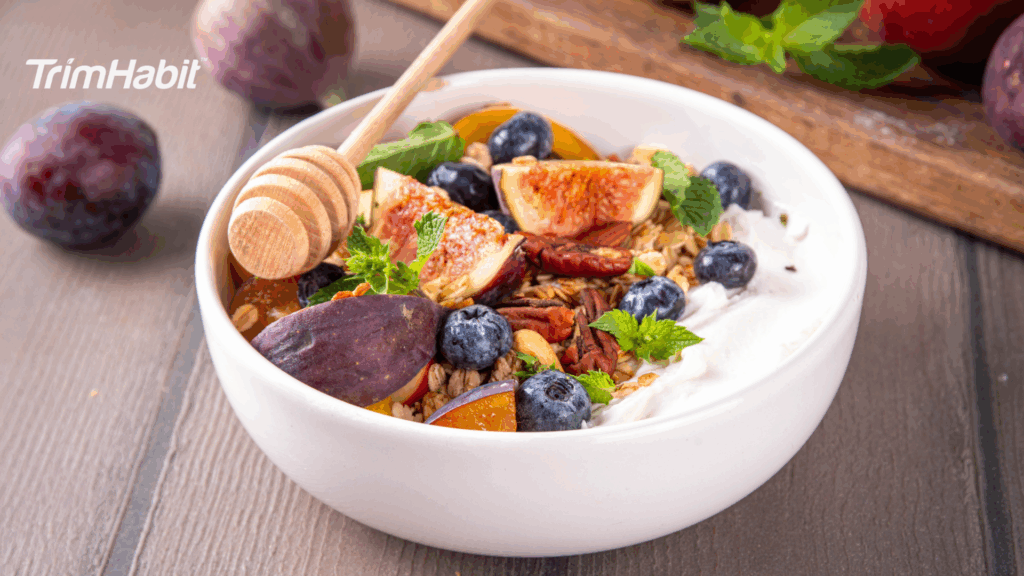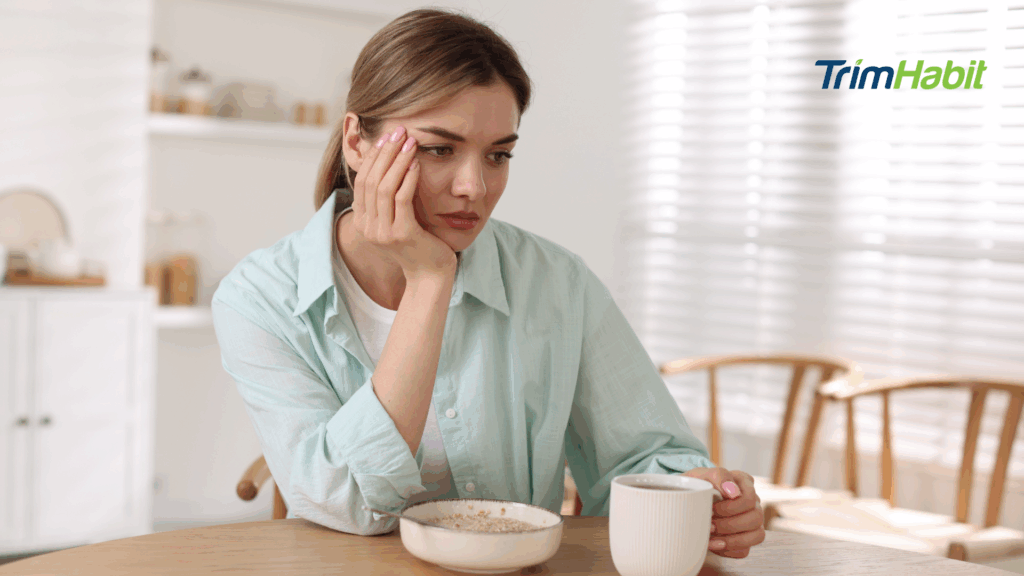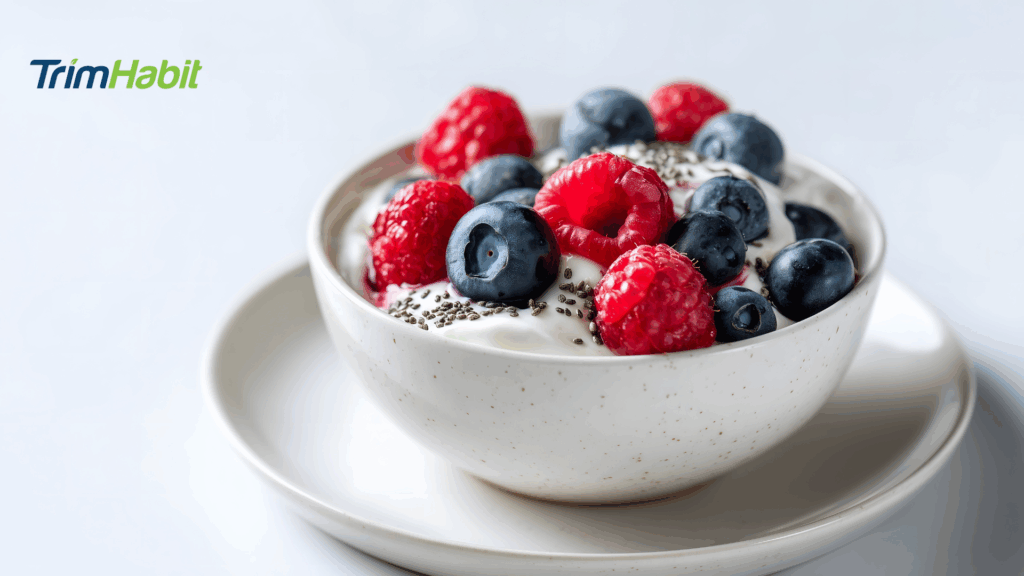People taking semaglutide often experience slower digestion. The medication mimics a hormone called GLP-1, which regulates appetite and slows how fast food leaves the stomach.
This process, known as delayed gastric emptying, helps control hunger and blood sugar but also changes how the body reacts to fiber. Since fiber expands and holds water in the digestive tract, eating too much of it too quickly can cause gas and bloating.
Learning how to add more fiber without causing bloating on semaglutide involves understanding how this medication interacts with digestion and how to adapt your eating habits to those changes.
When gastric emptying slows, meals remain in the stomach longer. That effect helps stabilize appetite and support weight loss, but it can make fiber harder to tolerate. If fiber ferments before it moves through the intestines, gas forms, and discomfort follows. The solution lies in gradual adjustments rather than sudden increases.
Why Fiber Matters For Metabolic Health
Fiber is not digested in the same way as other nutrients, yet it plays a major role in weight management and blood sugar regulation. Dietary fiber supports digestive function, keeps bowel movements consistent, and nourishes beneficial gut bacteria1. These effects strengthen digestion and help prevent glucose fluctuations that can interfere with energy balance.
Soluble fiber dissolves in water, forming a gel that slows nutrient absorption. This helps stabilize blood sugar levels, improve satiety, and extend energy release. Insoluble fiber adds structure and volume to stool, moving waste efficiently through the digestive tract. Both are essential for gut health, but the balance matters, especially when semaglutide is part of your treatment plan.
When used correctly, fiber supports weight loss and long-term blood sugar management2. It slows digestion in a way that complements semaglutide’s effects rather than competing with them. The combined action promotes steady hunger signals, better nutrient absorption, and fewer cravings.
How To Add More Fiber Without Causing Bloating On Semaglutide
Fiber And The Science Of Satiety
The link between fiber and appetite control is one of the strongest in nutrition research. Fiber expands in the stomach, triggering receptors that tell the brain you are full. For someone taking a weight loss drug like semaglutide, this means the sensation of fullness lasts longer and food cravings decline. Together, these factors reduce total food intake and support healthy changes in body weight.
However, this same mechanism can cause discomfort if you eat large amounts of fiber too fast. When digestion slows under the influence of semaglutide, extra fiber can sit in the stomach and ferment before it passes along. To prevent this, it helps to spread your fiber consumption across several small meals rather than eating it all at once.
How Much Fiber The Body Needs
Experts recommend 25 to 38 grams of fiber each day for adults, though the exact target depends on age and calorie intake. People using semaglutide should aim for the lower end of that range at first. Gradually increasing fiber intake gives the digestive system time to adapt. Adding about 3 to 5 grams every few days helps prevent bloating and allows beneficial bacteria in the gut to adjust naturally.
Hydration is equally important. Fiber draws water into the intestines to move waste along. Without enough fluid, digestion slows and discomfort increases. Drinking water consistently throughout the day prevents gas buildup and supports smooth transit through the digestive tract.
Choosing The Right Fiber Sources
When digestion slows, the type of fiber you eat matters as much as the amount. Cooked vegetables and peeled fruits are easier to digest than raw or coarse ones. Oats, bananas, and chia seeds provide soluble fiber that helps regulate blood sugar without triggering excessive fermentation. As your tolerance improves, you can add whole grains such as brown rice and barley to increase total fiber content gradually.
Whole wheat bread and other minimally processed grains also contribute to sustained fullness. These foods are rich in vitamins, minerals, and slow-digesting carbohydrates that complement semaglutide’s effects on blood sugar stability. Including fiber rich options in small, consistent portions across the day maintains comfort while supporting gut health.
Meal Balance For Digestive Comfort
A balanced meal plan can make or break fiber tolerance. Combining fiber with lean protein and healthy fats slows digestion in a controlled way that prevents spikes and drops in blood sugar. Lean proteins like poultry, tofu, eggs, and fish help repair tissue and maintain muscle during weight loss. Healthy fats from nuts, seeds, and olive oil promote satiety and nutrient absorption. Together, these components make meals more satisfying without overwhelming the digestive system.
Meal timing is another factor. Smaller, balanced meals eaten regularly help the body process nutrients evenly. Eating slowly and chewing thoroughly prevents the stomach from filling too quickly, giving semaglutide time to regulate gastric emptying naturally.
Adapting The Digestive System Gradually
Your gut needs time to adapt when fiber increases. The digestive microbiota feed on fiber, producing gases and short-chain fatty acids. At first, this can lead to bloating, but as the bacteria become accustomed to the higher substrate, symptoms fade. Introducing fiber slowly allows your body to adapt while still gaining the benefits of a high fiber diet.
Cooking vegetables, soaking beans, and blending fruits are effective methods for easing digestion. Gradual preparation changes reduce the physical structure of fiber, which makes it easier for the body to handle. Over several weeks, your tolerance improves, and GI symptoms lessen.
1-Week Sample Meal Plan
Day 1: Light and Gentle Start
- Breakfast: Scrambled eggs with spinach and a slice of whole wheat bread
- Snack: Small banana
- Lunch: Grilled chicken breast with mashed sweet potato and green beans
- Snack: Yogurt with a teaspoon of chia seeds
- Dinner: Baked salmon with white rice and steamed carrots
Goal: Begin with soft, hydrating foods and small portions of soluble fiber.
Day 2: Balance Fiber with Protein
- Breakfast: Smoothie with oats, protein powder, and unsweetened almond milk
- Snack: Handful of almonds
- Lunch: Turkey sandwich on whole wheat bread with lettuce and tomato
- Snack: Applesauce
- Dinner: Stir-fried tofu with zucchini and brown rice
Goal: Introduce gentle insoluble fiber while keeping meals easy to digest.
Day 3: Add Variety, Keep Portions Small
- Breakfast: Oatmeal topped with soft berries
- Snack: Cheese stick or small handful of nuts
- Lunch: Lentil soup with soft-cooked vegetables
- Snack: Yogurt
- Dinner: Grilled fish, mashed potatoes, and cooked spinach
Goal: Alternate high fiber meals with lighter options to prevent bloating.
Day 4: Support Digestion with Hydration
- Breakfast: Whole wheat toast with peanut butter
- Snack: Sliced pear
- Lunch: Quinoa bowl with chicken and mixed vegetables
- Snack: Rice cakes with a thin layer of almond butter
- Dinner: Baked tofu, brown rice, and steamed broccoli
Goal: Increase fiber slightly but drink plenty of water throughout the day.
Day 5: Blend Plant and Animal Proteins
- Breakfast: Smoothie with banana, spinach, and protein powder
- Snack: Greek yogurt with flaxseed
- Lunch: Lentil and vegetable stew
- Snack: Small handful of walnuts
- Dinner: Grilled chicken with roasted root vegetables
Goal: Use plant based proteins and soluble fiber for steady digestion.
Day 6: Maintain a Moderate Fiber Level
- Breakfast: Omelet with mushrooms and tomatoes
- Snack: Soft apple slices
- Lunch: Brown rice with tofu and steamed greens
- Snack: Yogurt or cottage cheese
- Dinner: Baked fish, quinoa, and roasted carrots
Goal: Keep fiber consistent while balancing lean protein and healthy fats.
Day 7: Keep Digestion Comfortable
- Breakfast: Overnight oats with unsweetened almond milk and chia seeds
- Snack: Half an avocado on whole grain crackers
- Lunch: Vegetable soup with lean beef pieces
- Snack: Smoothie with almond milk and berries
- Dinner: Chicken breast, barley, and sautéed green beans
Goal: Maintain comfort while achieving a steady daily fiber intake.
Foods To Limit Or Avoid
Certain foods interfere with the body’s ability to adapt to fiber. Fried foods, spicy foods, and greasy meals slow digestion and can increase discomfort when combined with semaglutide. Fried chicken or heavily seasoned dishes create extra strain on the stomach. Energy drinks and sugary foods can trigger blood sugar spikes that undo the benefits of fiber’s slow release of glucose. High sugar foods and processed snacks often replace more nutrient-dense, fiber-rich foods, reducing the nutritional value of meals.
It also helps to avoid foods that contain empty calories or cause irritation to the stomach. Choosing simpler, whole-food combinations helps keep digestion stable. As tolerance improves, variety can return without discomfort.
Using Fiber Supplements Safely
For some people, reaching the right amount of fiber through diet alone can be difficult. In such cases, a fiber supplement can fill the gap. Supplemental fiber such as psyllium husk, inulin, or methylcellulose can help meet daily fiber intake targets, but timing and portion size are critical. Adding too much too soon can make GI symptoms worse. Start with small amounts and increase slowly while maintaining hydration.
Before using any supplement, it is wise to consult a healthcare provider. Individual tolerance varies, especially for those taking medication that alters digestion. The provider can help determine which form and amount of fiber supplement is best suited to your needs.
Preventing Discomfort From Too Much Fiber
Too much fiber can cause bloating, gas, and abdominal pain. This often happens when dietary changes occur quickly or when hydration is inadequate. Reducing fiber slightly and increasing fluid intake usually relieves these symptoms. If discomfort persists, it may be due to delayed gastric emptying rather than the fiber itself. Adjusting meal size or timing often restores balance.
Pay attention to how your digestive system responds. If symptoms worsen, track what you eat and how you feel after each meal. This record helps identify which foods cause issues and allows for more precise adjustments.
The Role Of Gut Adaptation In Long-Term Comfort
As you increase fiber gradually, your body adjusts and becomes more efficient at digesting plant-based material. The gut microbiome becomes more diverse, improving digestion and reducing bloating. This adaptation also enhances nutrient absorption and supports better blood sugar control.
Over time, a diet rich in whole grains, fruits, vegetables, and plant-based proteins strengthens the digestive tract and supports weight control. Fiber-rich foods also help sustain energy, maintain fullness, and support long-term weight management without discomfort.
A Scientific Foundation For Lasting Success
Food science shows that fiber influences metabolism, hunger, and digestive speed in measurable ways. It slows digestion, stabilizes blood sugar, and supports microbial health, all of which improve metabolic efficiency. When aligned with semaglutide therapy, fiber serves as a nutritional tool that enhances results instead of creating side effects.
Careful attention to eating habits, hydration, and gradual change allows your body to tolerate more fiber comfortably. This balance preserves digestive comfort while helping you lose weight and sustain progress. It also strengthens gut resilience, which becomes essential for maintaining a healthy diet long-term.
Conclusion
Adding fiber while using semaglutide does not need to lead to discomfort. The secret lies in pacing and precision. Increase your fiber intake gradually, drink enough water, and pair high-fiber foods with lean proteins and healthy fats. Eat slowly and consistently to match your medication’s effects on digestion. Avoid foods that interfere with absorption or slow motility, and rely on variety to train your digestive system to adapt.
Through these adjustments, fiber becomes an essential support for your weight loss journey. It supports gut health, helps stabilize blood sugar, and improves your ability to maintain steady body weight. When guided by specific dietary guidelines and careful observation, fiber can enhance the benefits of semaglutide while keeping digestion comfortable and sustainable.









